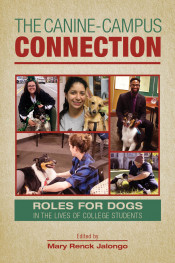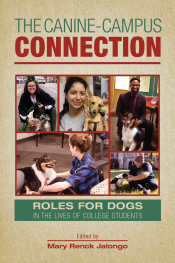

The Canine-Campus Connection: Roles for Dogs in the Lives of College Students (Purdue University Press) is a serious book, not a collection of picture of dogs on the quad. Mary Renck Jalongo, the editor, has gathered (and written) essays on the history of dogs on campus, service dogs, dogs in class, etc.
Jalongo has written, co-written or edited more than 30 books. She is a tester/observer for the Alliance of Therapy Dogs and has completed hundreds of visits and presentations with her four therapy dogs since 2006. In collaboration with a state prison, she works with inmates to train service dogs for people with disabilities. She responded via email to questions about her book.
Q: Why are dogs important to campuses? For how long has this been true?
Most Popular
A: When the interactions between a person and dog are positive and reciprocal, there are documented neurophysiological changes in both species. Levels of oxytocin, the “feel-good hormone,” tend to increase significantly, while levels of cortisol, the “stress hormone,” tend to decrease. National surveys of college students suggest that mental health issues — particularly stress and anxiety disorders — were on the rise prior to COVID-19. Research on previous pandemics suggests that they have long-term, negative effects on well-being, so providing opportunities for positive human/canine interaction is part of an overall stress reduction strategy on campus.
The presence of dogs on campus was the relative rarity prior to the emergence of trained visiting dogs, referred to as therapy dogs or sometimes, comfort dogs. Therapy dogs are house-trained, nonaggressive dogs that are trained beyond basic obedience. Their owner/handlers typically are affiliated with a national or international organization, and the team is covered by liability insurance. One activity that attracted attention during the 1990s was bringing dogs to interact with students during exam week, as a stress-reduction strategy; it is now a popular event on many campuses. Increasingly, wellness and counseling centers involve therapy dogs and, in some instances, a therapy dog who belongs to a staff member accompanies them to work each day. If you see a group of people/dog teams on campus, they probably are therapy dogs.
Dogs on campus can be a recruitment tool, with various higher education institutions promoting the fact that they offer at least one pet-friendly residence hall. Further, some campus security personnel are finding that a working dog owned by law enforcement can detect explosives (e.g., bomb threat), identify illegal substances (e.g., drugs) or track a missing/abducted person. Increasingly, campus security personnel are finding that victims of a crime and people who are interviewed as witnesses will opt to have a therapy dog present during those stressful events. Some campus security facilities now have dogs on-site to provide student and staff support.
Q: Service dogs are a special category of dogs. How prevalent are they in higher education? What changes are you seeing in them?
A: It is difficult to identify the number of service dogs because there is no central registry; however, it is estimated that there are a total 500,000 service dogs in the United States. Statistics specific to college students and faculty are not available. The Americans With Disabilities Act guarantees public access for service dogs, so higher education is obligated to make provisions for them to accompany a person with a diagnosed disability. This is the only category of dog that is permitted to go everywhere on campus — to classes, dining areas and dormitories, for example.
A service dog is, by definition, individually trained to assist a person with a disability. It is acceptable to ask just two questions: (1) Is the animal required because of your disability? and (2) What tasks has your dog been trained to perform for you? It is not acceptable to ask the person to explain what their disability is. Some examples of service dogs are mobility assistance service dogs, who provide support when walking and retrieve objects for their person; hearing assistance dogs, who alert to sounds; guide dogs for persons who are blind; and — more recently — seizure alert dogs (who may anticipate an oncoming seizure, presumably by scent, and lead the person to a safe place, stay with them or go and get help), and dogs that alert to dangerously high or low blood sugar levels in people with diabetes.
One interesting development is that some college campuses are giving college students the opportunity to be service dog puppy raisers. The dogs then “graduate” from the on-campus program that typically lasts for the entire academic year. After that, the dogs would enter advanced training to prepare them to work as a team for a person who has a disability. Service dog training typically takes around two years — longer for guide dogs for the blind.
Q: What about emotional support dogs? How widespread are they in higher education?
A: There is considerable confusion about emotional support dogs. They are not covered by the Americans With Disabilities Act and do not have public access rights. Many people mistakenly believe that an emotional support dog can go anywhere, when this definitely is not the case. Emotional support dogs are brought to campus under the provisions of the Fair Housing Act, so that is what emotional support dogs have permission to do — live with the student and [be in] outdoor areas designated for them. Emotional support dogs do not go to classes, ride the bus, go to the library or accompany the student to any areas designated as a no-pets zone. They are not necessarily trained beyond house-training.
A person requesting to bring their emotional support dog to campus would have a diagnosed mental health issue, be in treatment with a licensed mental health professional and obtain a letter on professional letterhead documenting the need for the emotional support animal. Many postsecondary institutions have an application/approval process for bringing emotional support dogs (and some other animals) to campus. The owner of the dog needs to sign a contract outlining their obligations to the animal, other residents and the campus community at large. The dog’s owner is responsible for proper care and medical treatment and liable for any damage caused by the dog. If it is on-campus housing, the roommate(s) have to agree to the housing arrangements, of course. Emergency preparedness procedures need to be outlined, and institutions of higher education need to establish a policy concerning the removal of a dog if it creates a problem. The presence of emotional support dogs on campus is not widespread at this time, but the expectation is that the requests from students will increase.
Q: Would you describe the role that dogs play in college courses?
A: Usually, if a dog comes to class, it is by invitation of the instructor, because the role that the dog plays is relevant to the professional training of the students. Some examples include: a military war dog and handler who visit an ROTC group, therapy dogs and handlers who visit a wellness course for counselors, a search-and-rescue dog team who visit classes for first responders, or a service dog in training who visits a class in special education. The dog’s presence in the class should be clearly linked to goals of the program and to course objectives.
Many nurses, for example, will encounter therapy dogs who visit to elevate positive mood and encourage compliance with treatment plans in their patients. At some health-care facilities, there are specially trained dogs that are in the workplace regularly. Orienting nurses to these situations prepares them for what they will experience during their practicum experiences and beyond, after they secure employment. Special education majors might have a guest speaker and meet a child with their service dog so that future teachers are familiar with this type of working dog that might be present in the classroom. Another role for student/canine interaction is volunteering with animal welfare groups to fulfill community service hours. Students may provide direct animal care (e.g., feeding, walking, postsurgical health monitoring) as well as other tasks related to their majors (e.g., web design/maintenance, promoting adoption on social media).
Q: I was raised with cats (and love cats). Why have they lagged on campus?
A: Cats are not pack animals and generally are less trainable than dogs. However, Pet Partners, the only organization in the U.S. that tests and registers a variety of species as therapy animals, reports that there are 200 therapy cats nationwide. It is possible to have a therapy cat, but it would need to be accepting of contact with many different people. It takes an exceptionally laid-back, sociable and trained cat. A more likely role for cats on campus would be as an emotional support animal for an individual student. The university would need to have pet-friendly housing, make sure that other students are not adversely affected (e.g., due to allergies) and arrange the situation so that everyone accepts the presence of the cat.